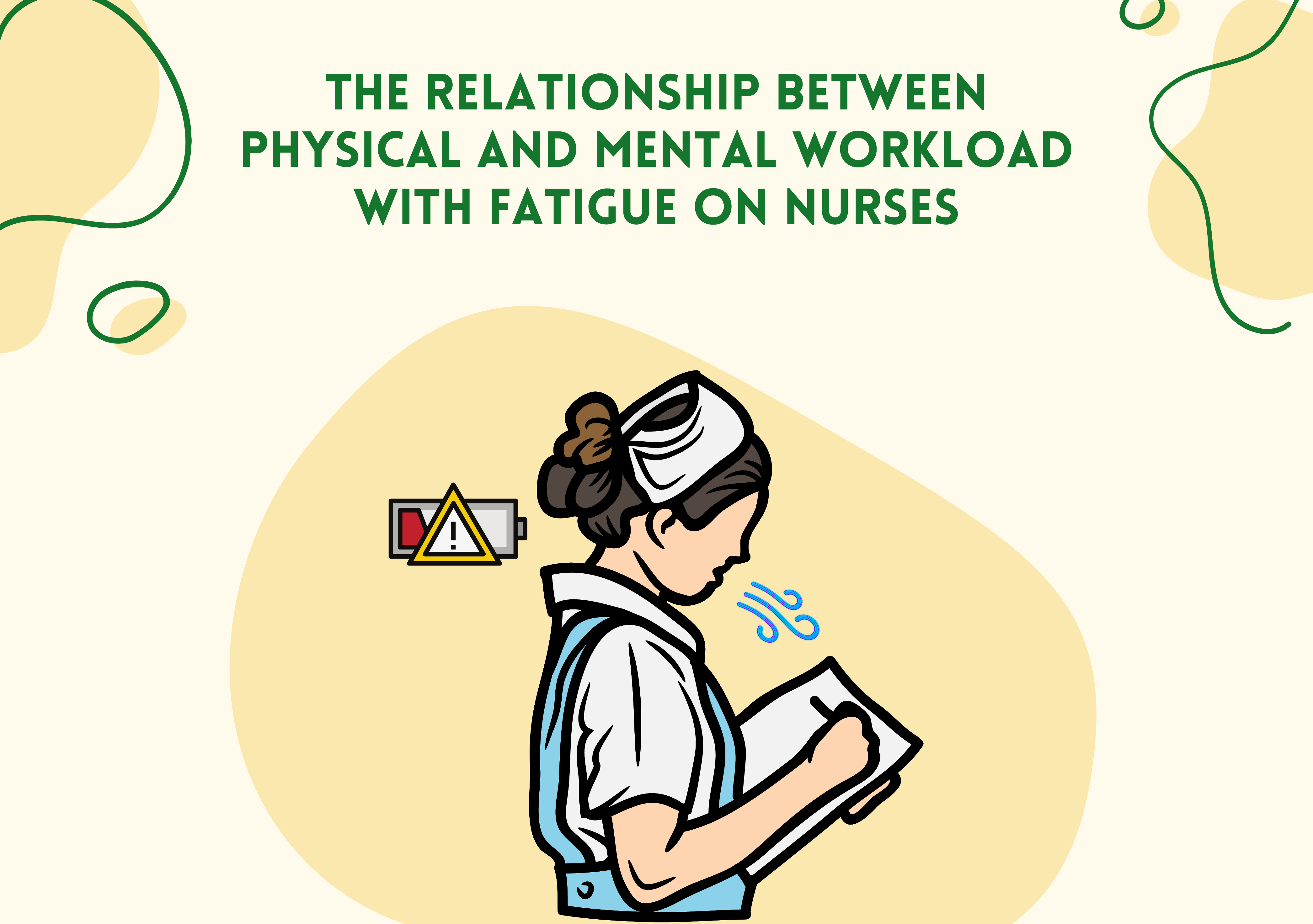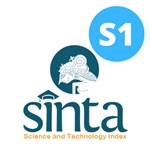The Relationship Between Physical And Mental Workload With Fatigue On Nurses

Downloads
Introduction: Workload and work fatigue are problems that often arise in a hospital. The unbalanced workload of nurses can cause work fatigue in the nurse workforce. If nurses experience work fatigue, the work motivation of the nurses will decrease, performance is low, work quality is low, there are many mistakes, low work productivity, work-related stress, occupational diseases, injuries, and work accidents. This study aims to analyze the relationship between physical workload and mental workload with work fatigue on nurses in the Emergency Room at Haji General Hospital Surabaya. Methods: This study was an observational study with a cross sectional study design. Conducted in the Emergency Room Installation of Haji General Hospital Surabaya with a research population of 30 nurses. The sampling technique was total sampling. The independent variable in this study is physical workload and mental workload while the dependent variable in this study is work fatigue. Data collection using direct measurement instruments in the form of a Pulse Oxy Meter, NASA-TLX and IRFC questionnaires with statistical analysis using the contingency coefficient test and the Spearman correlation test. Results: This study shows that physical workload has a very weak relationship with work fatigue on nurses (correlation coefficient 0.198) while mental workload has a strong enough relationship with work fatigue in acne (correlation coefficient 0.535). Conclusion: it can be concluded that physical workload and mental workload have a relationship with work fatigue on nurses in the Emergency Department of the Haji General Hospital of Surabaya.
Keywords: Fatigue, mental workload, physical workload
Allo, A. A. et al. (2020) ‘Work Fatigue Determination of Nurses in Hospital of Hasanuddin University', Journal of Asian Multicultural Research for Medical and Health Science Study, 1(2). pp 33-41
Ardiyanti, N., Wahyuni, I. and Jayanti, S. (2017) ‘Hubungan Beban Kerja Mental dengan Kelelahan Kerja pada Tenaga Keperawatan dan Tenaga Kebidanan di Puskesmas Mlati II Sleman Yogyakarta', Jurnal Kesehatan Masyarakat (e-Journal), 5(5), pp. 264–272.
Arini, S. Y. and Dwiyanti, E. (2017) ‘Analisis Faktor yang Berhubungan dengan Terjadinya Kelelahan Kerja pada Pengumpul Tol di Perusahaan Pengembang Jalan Tol Surabaya', The Indonesian Journal of Occupational Safety and Health, 4(2), pp. 113-122.
Astuti, F. W., Ekawati, E. and Wahyuni, I. (2017) ‘Hubungan antara Faktor Individu, Beban Kerja dan Shift Kerja dengan Kelelahan Kerja pada Perawat di RSJD Dr. Amino Gondohutomo Semarang', Jurnal Kesehatan Masyarakat (e-Journal), 5(5), pp. 163–172.
Boy, P. et al. (2020) ‘Hubungan Beban Kerja dengan Kelelahan Kerja pada Perawat di Gedung Instalasi Rawat Inap Terpadu', Jurnal Kesmas Prima Indonesia, 2(8), pp. 46–50.
Bunga, S. et al (2021) ‘Faktor Yang Mempengaruhi Kelelahan Kerja Pada Tenaga Kesehatan Lapangan Dompet Dhuafa Pada Masa Pandemi Covid 19', Health Publica: Jurnal Kesehatan Masyarakat, 2(1), pp. 40–51.
Gaol, M. J. L., Camelia, A. and Rahmiwati, A. (2018) ‘Analisis Faktor Risiko Kelelahan Kerja pada Karyawan Bagian Produksi PT. Arwana Anugrah Keramik, Tbk', Jurnal Ilmu Kesehatan Masyarakat, 9(1), pp. 53–63.
Kondi, A. E. and Herlina (2019) ‘Faktor-Faktor yang Berhubungan dengan Kelelahan Kerja pada Perawat di Rumah Sakit Awal Bross Bekasi', Jurnal Persada Husada Indonesia, 6(20),pp. 1-9
Izzati, F. E. (2021) ‘Hubungan Beban Kerja Fisik dan Mental Dengan RSUD Kota Padang Panjang di Masa Pandemi Covid 19'. Undergraduate Thesis. Faculty of Public Health Universitas Andalas.
Kusumaningsih, D. et al. (2020) ‘Hubungan Beban Kerja Fisik Dan Mental Perawat Dengan Penerapan Pasien Safety Pada Masa Pandemi Covid 19 Di UPT Puskesmas Rawat Inap Kabupaten Pesawaran', Indonesian Jurnal of Health Development, 2(2), pp. 108–118.
Maharja, R. (2015) ‘Analisis Tingkat Kelelahan Kerja Berdasarkan Beban Kerja Fisik Perawat di Instalasi Rawat Inap RSU Haji Surabaya', The Indonesian Journal of Occupational Safety and Health, 4(1), pp. 93-102.
Malekpour, F., et al (2014) ‘Assessment Of Mental Workload in Nursing by Using NASATLX', Nursing and Midwifery Journal, 11(11), pp. 892–899.
Mirzaei, S., Zamanian, Z., and Zade, H. J. (2015) ‘Effects of Work Shifts and Mental Workload on Chronic Fatigue among Female Nurses in Intensive Care Units', Journal of Health Sciences & Surveillance System, 3(3), pp. 113–118.
Motamedzade, M. et al. (2017) ‘Mental Workload and its Association with Fatigue in Operating Room Personnel of Hamadan Hospitals, Iran, 2016', Journal of Occupational Health and Epidemiology, 6(2), pp. 98–105.
Mulfiyanti, D. (2020) ‘Hubungan Beban Kerja Dengan Kelelahan Kerja Pada Perawat Di RSUD Tenriawaru Kelas B Kabupaten Bone Tahun 2018', Jurnal Ilmiah Keperawatan, 6(2), pp 205-210.
Mulyadi and Hamel, R. S. (2018) ‘Perbedaan Tingkat Kelelahan Kerja Perawat di Unit Gawat Darurat dan Poliklinik Rumah Sakit Umum GMIM Pancaran Kasih Manado', Jurnal Keperawatan, 6(2), pp. 1-7.
Musta'in et al. (2021) ‘Hubungan Antara Stres Kerja Dengan Kelelahan Kerja Pada Perawat Di Masa Pandemi Covid-19 Di Unit Pelayanan Kesehatan Daerah Surakarta', Jurnal Keperawatan, 13(1), pp. 213–226.
Oksandi, H. R. and Karbito, A. (2020) ‘Faktor-Faktor yang Berhubungan Dengan Kelelahan Kerja Pada Perawat Di RSUD dr.H.BOB Bazar Kalianda Kabupaten Lampung Selatan Hendro', Jurnal Ilmi Kesehatan Indonesia (JIKSI), 1(1), pp. 1–7.
Perwitasari, D. and Tualeka, A. R. (2018) ‘Faktor yang Berhubungan dengan Kelelahan Kerja Subyektif pada Perawat Di RSUD Dr. Mohamad Soewandhie Surabaya', The Indonesian Journal of Occupational Safety and Health, 6(3), pp. 362-370.
Pongantung, M., Kapantouw, N. H. and Kawatu, P. A. T (2018) ‘Hubungan antara Beban Kerja dan Stres Kerja dengan Kelelahan Kerja pada Perawat Rumah Sakit GMIM Kalooran Amurang', Kesmas, 7(5), pp. 1-7.
Pourmovahed, Z. (2017) ‘Perception of Fatigue in Female Nurses Employed in Hospitals', Women's Health, 3(1), pp. 1–7.
Purba, Y. S. (2015) ‘Hubungan Beban Kerja Mental Dan Peerilaku Perawat Pelaksana Dengan Keselamatan Pasien', Jurnal Impuls Universitas Binawan, 1(2), 59-65.
Pratiwi, D. A. D. and Setyawan, D. (2017) ‘Gambaran Tingkat Kelelahan Kerja Perawat di Ruang Perawatan Intenif', Jurnal Jurusan Keperawatan, pp. 1–8.
Rahman, N. H. (2017) ‘Analisis Tingkat Kelelahan Kerja Perawat Di Ruang UGD RSP Unhas dan RSUP Dr. Wahidin Sudirohusodo Makassar'. Undergraduate Thesis. Makassar: Faculty of Medicine and Health Science Universitas Islam Negeri Alauddin Makassar
Rachmawati, D. and Paskarini, I. (2021) ‘Correlation between Individual Characteristics and Rest Break with Work-related Fatigue on Telecommunication Network Service Workers', The Indonesian Journal Of Occupational Safety and Health, 10(1), pp. 25-33.
Retnaningsih, D. and Fatmawati, D. F. (2016) ‘Beban Kerja Perawat terhadap Implementasi Patient safety di Ruang Rawat Inap', Jurnal Keperawatan Soedirman, 11(1), pp. 44-52.
Retnosari, D. F. and Dwiyanti, E. (2017) ‘Hubungan antara Beban Kerja dan Status Gizi dengan Keluhan Kelelahan Kerja Pada Perawat Instalasi Rawat Jalan di RSI Jemursari', Jurnal Ilmiah Keperawatan (Scientific Journal of Nursing), 3(1), pp. 8–17.
Rizqiansyah, M. Z. A. (2017) ‘Hubungan antara Beban Kerja Fisik dan Beban Kerja Mental Berbasis Ergonomi terhadap Tingkat Kejenuhan Kerja pada Karyawan PT Jasa Marga (Persero) Tbk Surabaya Branch Gempol', Jurnal Sains Psikologi, 6(1), pp. 37–42.
Sabaruddin, E. E. and Abdillah, Z. (2020) ‘Hubungan Asupan Energi, Beban Kerja Fisik, dan Faktor lain dengan Kelelahan Kerja Perawat', Jurnal Kesehatan, 10(2), pp. 107–117.
Steege, L. M. et al. (2017) ‘Exploring Nurse Leader Fatigue: A Mixed Methods Study', Journal of Nursing Management, 25(4), pp. 276–286.
Tarwaka (2015) Ergonomi Industri: Dasar-Dasar Pengetahuan Ergonomi dan Aplikasi di Tempat Kerja. Revisi Edisi II. Surakarta: Harapan Press.
Verawati, L. (2016) "Hubungan Tingkat Kelelahan Subjektif dengan Produktivitas pada Tenaga Kerja Bagian Pengemasan di CV Sumber Barokah', The Indonesian Journal of Occupational Safet and Health., 5(1), pp. 51–60.
Wang, X. (2019) ‘Subtypes of Nurses ' Mental Workload and Interaction Patterns with Fatigue and Work Engagement During Coronavirus Disease 2019 ( COVID-19 ) Outbreak : A Latent Class Analysis Shanghai University of Traditional Chinese Medicine Shanghai University of Tradi', 2019, pp. 1–18.
Wirdah, H. and Yusuf, M. (2016) ‘Penerapan Asuhan Keperawatan oleh Perawat Pelaksana di Rumah Sakit Banda Aceh', PSIK Unsyiah, 1(1), pp. 1–6.
Yudiah, W., Yudianto, K. and Prawesti, A. (2018) ‘Fatigue and Work Satisfaction of Emergency Nurses in Bandung, West Java, Indonesia', Belitung Nursing Journal, 4(6), pp. 602–611.
Yudi, D., Tangka, J. W. and Wowiling, F. (2019). ‘Hubungan Beban Kerja Fisik Dan Mental Perawat Dengan Penerapan Patient Safety Di IGD Dan ICU RSU Gmim Pancaran Kasih Manado', Jurnal Keperawatan, 7(1), pp. 1-9.
Copyright (c) 2023 The Indonesian Journal Of Occupational Safety and Health

This work is licensed under a Creative Commons Attribution-NonCommercial-ShareAlike 4.0 International License.

In order to be accepted and published by The Indonesian Journal of Occupational Safety and Health, Author(s) who submit an article should complete all the review process. The copyright of received articles assigned to the The Indonesian Journal of Occupational Safety and Health and Department of Safety and Health, Universitas Airlangga as publishers of the journal. The intended copyright includes the rights to publish articles in various forms (including reprints).
The Editorial Team of The Indonesian Journal Of Occupational Safety and Health and Department of Safety and Health strive to ensure that no errors occur in the articles that have been published, both data errors and statements in the article.
Users of this website will be licensed to use materials from this website following the Creative Commons Attribution-NonCommercial-ShareAlike 4.0 International License. No fees charged. Please use the materials accordingly.
------------------------------------------------------------------------------------------------------------------------------------------------------------------------------------------
Attribution ” You must give appropriate credit, provide a link to the license, and indicate if changes were made. You may do so in any reasonable manner, but not in any way that suggests the licensor endorses you or your use.
NonCommercial ” You may not use the material for commercial purposes.
ShareAlike ” If you remix, transform, or build upon the material, you must distribute your contributions under the same license as the original.







 How to Submit Articles in OJS
How to Submit Articles in OJS

























